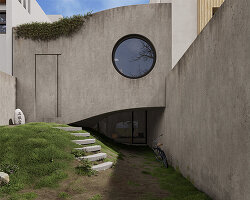
Snøhetta Reveals Contemporary Minimalistic Hiking Refuge in the Pyrenees

**Snøhetta’s Upcoming Mountain Refuge in the Pyrenees: A Sustainable Haven for Hikers and Nature**
The prestigious architectural firm **Snøhetta** is launching a project in the depths of **Pyrenees National Park**, aiming to create a crucial rest stop for trekkers while honoring the natural landscape. In an endeavor that merges architecture, eco-friendliness, and the breathtaking views of the Pyrenees, this new mountain refuge will take the place of the Barroude refuge, which sadly was lost to an accidental fire ten years ago.
Located within the **Cirque de Barroude** ecological site, the fresh design aspires to blend effortlessly with the neighboring flora and fauna, remaining true to Snøhetta’s **environmental principles** of minimal impact and sustainable practices.
### **Considerate Design in Harmony with Nature**
The reconstruction strategy by Snøhetta showcases profound regard for the local environment. The new refuge will include a **planted roof** that merges with the landscape, reducing visual interference in the natural setting. With a compact structure designed to shield the building from the often-harsh elements of the Pyrenees, it will also utilize **recycled aluminum cladding** to protect the refuge against severe weather and high winds.
This shelter will consist of two levels, cleverly adapting to the existing terrain to fit more naturally into the site. The refuge will not only cater to tired hikers but also offer support to **National Park personnel**, providing essential warmth and shelter in the wilderness.
### **A Warm Yet Simple Interior**
The interior design of the structure aims for a cozy yet minimalist vibe, consistent with its rugged setting. The layout emphasizes practicality, separating the space into two areas: **communal zones** and **private rest spaces**. Visitors arriving at the refuge will encounter a **reception area** alongside shared facilities like a **kitchen** and **dining area**, ideal for recharging before continuing their journeys.
In contrast to the **dormitories**, the living areas will allow fatigued hikers and park staff to rest in solitude. The refuge will provide a range of accommodation types, from direct-access **winter dorms** for overnight stays to larger **six- to eight-person rooms** suited for group visits. Additionally, there will be **lodgings for the park’s maintenance team and technicians**, ensuring comfort for both staff and guests in this secluded environment.
### **A Serious Commitment to Sustainability**
A standout feature of Snøhetta’s design philosophy is the firm’s focus on **sustainable construction techniques**. The planned refuge not only seeks to minimize its ecological impact by utilizing recycled and locally sourced materials but also emphasizes efficient energy and resource use.
– The **green roof**, in conjunction with **local stone** in its structure, not only sustains visual cohesion with the environment but also offers natural insulation, enhancing the building’s energy efficiency.
– Energy production will be tackled through **photovoltaic (solar) panels**, while **biomass heating** ensures a cozy interior without reliance on detrimental fossil fuels. These steps greatly lessen the refuge’s dependence on non-renewable energy, significantly reducing **greenhouse gas emissions**.
– **Drinking water** will be collected from a **nearby spring** and stored in special tanks. Furthermore, an eco-friendly **wastewater treatment system** will use infiltration methods to manage sewage without polluting the local surroundings—guaranteeing the refuge remains as considerate to the landscape as feasible.
Together, these initiatives ensure that both hikers and park staff can relish their experience in the refuge while minimizing their footprint on the nearby nature—safeguarding the national park for generations to come.
### **Timeline and Expectations for the Project**
Construction of the new Barroude Refuge is set to commence in **2025**. Following the current timeline, the refuge should be finished and ready for visitors by **2027**. The design and construction focus on **efficiency and speed**, particularly limiting **concrete bases and earthworks** to promote rapid development while lessening environmental impact throughout the building phase.
A decade after the original Barroude refuge’s loss, Snøhetta’s forthcoming shelter aims to serve as a beacon of **comfort, sustainability, and resilience** for the many hikers visiting the Pyrenees annually, as well as the maintenance and observation crews of the park.
### **Conclusion: A Shelter that Supports Both People and the Planet**
More than just a replacement for a lost refuge, Snøhetta’s new mountain shelter in the Pyrenees exemplifies the potentials of **modern sustainable architecture**. By incorporating natural forms and materials, the design skillfully navigates the harsh climatic conditions typical of mountainous areas while also maintaining an admirable **low environmental footprint**.